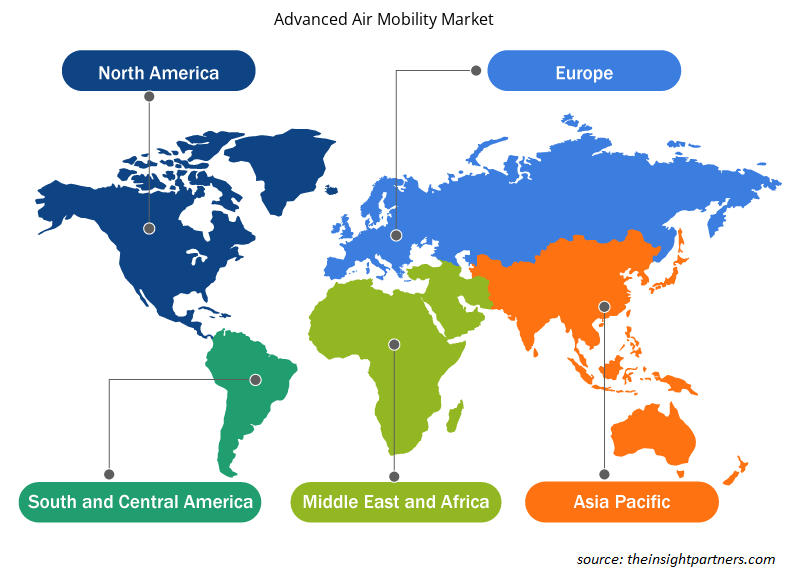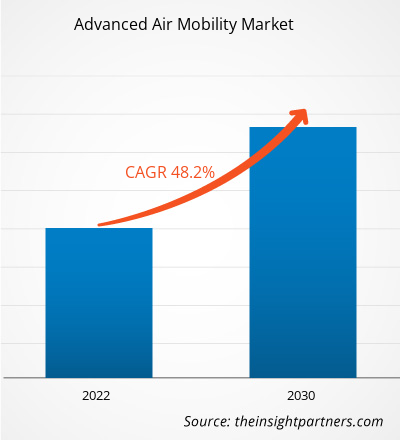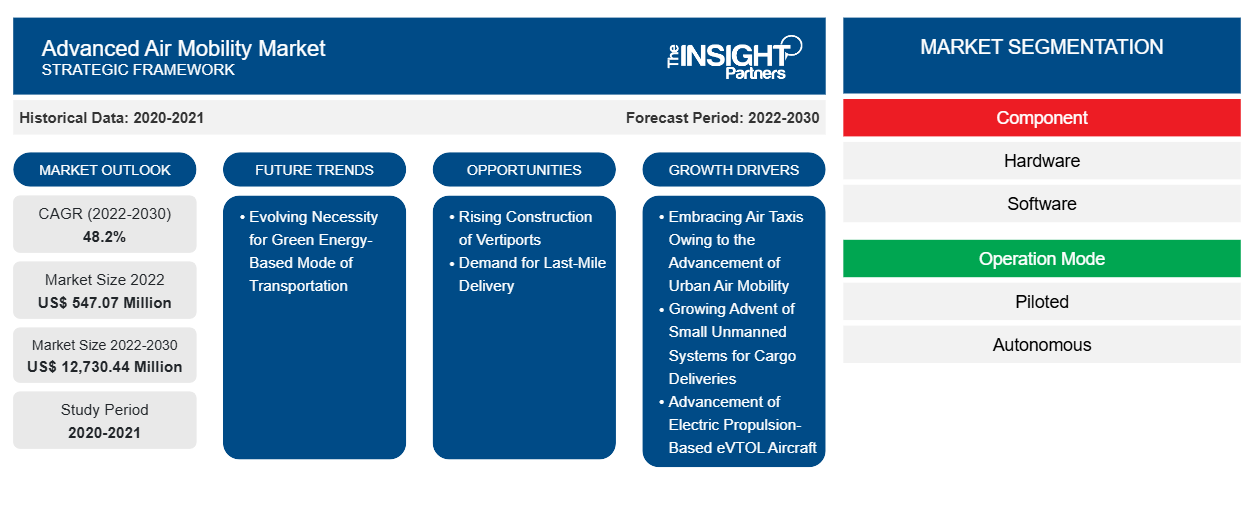Il mercato della mobilità aerea avanzata è stato valutato a 547,07 milioni di dollari nel 2022 e si prevede che raggiungerà i 12.730,44 milioni di dollari entro il 2030; si prevede che crescerà a un CAGR del 48,2% dal 2022 al 2030. La crescente necessità di modalità di trasporto basate sull'energia verde rimarrà probabilmente una tendenza chiave del mercato della mobilità aerea avanzata.
Analisi di mercato della mobilità aerea avanzata
I principali stakeholder nel mercato AAM includono fornitori di materie prime e componenti, produttori di batterie e utenti finali. Poiché il mercato degli aeromobili eVTOL non è ancora stato commercializzato ed è ancora in fase di test e sviluppo, anche i produttori di batterie e altri componenti per le aziende di aeromobili AAM si stanno concentrando sullo sviluppo di tecnologie di batterie nuove e innovative per avere un vantaggio di early mover nel mercato, poiché molte aziende stanno cercando di entrare nel settore AAM.
Panoramica del mercato della mobilità aerea avanzata
La mobilità aerea urbana è un aspetto completamente nuovo del trasporto aereo che offre nuove opportunità agli stakeholder dell'aviazione e aiuta lo sviluppo di aeromobili eVTOL. Molte aziende stanno sviluppando aeromobili eVTOL e sono supportate da investitori e autorità aeronautiche. Ad esempio, nell'ottobre 2021, la Civil Aviation Authority (CAA) del Regno Unito ha istituito un nuovo consorzio internazionale incentrato sulla sicurezza di sviluppatori e operatori di aeromobili eVTOL durante l'HeliTech Expo di Londra. Questo nuovo consorzio ha il compito di considerare le sfide di sicurezza che devono essere risolte per consentire agli aeromobili eVTOL e ai taxi drone di essere commercialmente disponibili sul mercato. Nel 2018, l'Organizzazione internazionale per l'aviazione civile (ICAO) con sede a Montreal, in Canada, ha fondato l'organizzazione non-profit chiamata Ambular. L'obiettivo di Ambular è sviluppare un aeromobile open source per servizi medici di emergenza (EMS) eVTOL. Le tecnologie degli aeromobili eVTOL sono attualmente in fase di sviluppo e sperimentazione. Tuttavia, sfide come l'infrastruttura di terra, i costi economici o la densità energetica delle batterie dovrebbero essere superate dagli operatori che operano nel mercato della mobilità aerea avanzata
Personalizza questo report in base alle tue esigenze
Riceverai la personalizzazione gratuita di qualsiasi report, comprese parti di questo report, o analisi a livello nazionale, pacchetto dati Excel, oltre a usufruire di grandi offerte e sconti per start-up e università
-
Scopri le principali tendenze di mercato in questo rapporto.Questo campione GRATUITO includerà analisi di dati che spaziano dalle tendenze di mercato alle stime e alle previsioni.
Driver e opportunità del mercato della mobilità aerea avanzata
L'avvento dei piccoli sistemi senza pilota per le consegne di merci
Il progresso tecnologico nel campo della mobilità aerea sta guidando lo sviluppo di piccoli droni senza pilota per le consegne di merci. La crescente domanda di consegne rapide in giornata di spedizioni e la necessità di consegnare forniture essenziali in luoghi irraggiungibili e remoti stanno aumentando la domanda di piccoli droni senza pilota. I droni aerei senza pilota possono essere utilizzati per consegnare una gamma di merci, che include principalmente pezzi di ricambio, beni commerciali, forniture mediche, prodotti alimentari e vaccini. Inoltre, i droni aerei senza pilota possono anche essere utilizzati per consegnare la posta in cantieri remoti o siti offshore. La crescente proliferazione di droni senza pilota nei servizi di logistica e trasporto merci. Ad esempio, nel 2022, Skye Air Mobility ha collaborato con Dunzo per testare e provare servizi di consegna di cibo guidati da droni in Karnataka. Nel 2022, Swiggy ha collaborato con Garuda Aerospace per provare i droni per consegnare generi alimentari a Bengaluru e Delhi NCR. Anche i droni cargo stanno guadagnando slancio in quanto rappresentano un'opzione praticabile per mitigare l'impronta di carbonio e ridurre il livello di inquinamento ambientale. La crescente attenzione alla riduzione dell'impronta di carbonio nel settore della logistica e dell'aviazione sta stimolando lo sviluppo dei droni cargo a livello globale. Ad esempio, nel 2021, Leonardo SpA ha completato la prima sperimentazione della sua consegna basata su droni "Sumeri Moderni" a Torino. Nel 2022, FedEx Corp. ha collaborato con Elroy Air per sperimentare il suo sistema di trasporto aereo autonomo eVTOL per le operazioni logistiche di medio miglio entro il 2023.eVTOL air cargo system for middle-mile logistics operations by 2023.
Crescente costruzione di vertiporti: un’opportunità nel mercato della mobilità aerea avanzataVertiports – An Opportunity in the Advanced Air Mobility Market
I vertiport sono centri per veicoli a decollo e atterraggio verticale come veicoli eVTOL, droni e taxi aerei. La crescente domanda di trasporti urbani competenti e gli sviluppi nella tecnologia eVTOL e la carenza di terreni disponibili per costruire vertiport convenzionali alimentano la necessità di vertiport avanzati, che, in un certo senso, sono uno dei punti di riferimento per il mercato della mobilità aerea avanzata a livello globale. Nel 2022, VPorts ha dichiarato di stabilire una rete di vertiport nel Quebec e di formare corridoi tra il Quebec e gli Stati Uniti specificamente per gli aeromobili eVTOL. L'azienda mirava anche ad avviare voli di prova eVTOL nel 2023. Nel 2023, Siemens e Skyway hanno collaborato per garantire l'infrastruttura digitale ed elettrica necessaria per facilitare le operazioni del vertiport. Nel 2023, Ferrovial Airports ha collaborato con Eva Air Mobility per sviluppare vertiport per aeromobili eVTOL. La crescente domanda di approcci sostenibili e a basse emissioni di carbonio nel settore dell'aviazione e della logistica aumenta la domanda di servizi di mobilità aerea avanzati. are centers for vertical takeoff and landing vehicles such as eVTOL vehicles, drones, and air taxis. The increasing demand for competent urban transportation and developments in eVTOL technology and the shortage of available land to build conventional vertiports fuel the need for advanced vertiports, which, in a way, is one of the landmarks for the advanced air mobility market globally. In 2022, VPorts declared to establish a network of vertiports in Quebec and to form corridors between Quebec and the US specifically for eVTOL aircraft. The company also aimed at starting eVTOL test flights in 2023. In 2023, Siemens and Skyway collaborated to ensure the digital and electrical infrastructure required to facilitate vertiport operations. In 2023, Ferrovial Airports collaborated with Eva Air Mobility to develop vertiports for eVTOL aircraft. The growing demand for sustainable and low-carbon emission approaches in the aviation and logistics sector boost the demand for advanced air mobility services.
Analisi della segmentazione del rapporto di mercato sulla mobilità aerea avanzata
I segmenti chiave che hanno contribuito alla derivazione dell'analisi di mercato della mobilità aerea avanzata sono i componenti, la modalità operativa, il tipo di propulsione e l'uso finale.
- In base ai componenti, il mercato della mobilità aerea avanzata è diviso in hardware e software. Il segmento hardware ha detenuto una quota di mercato maggiore nel 2022.
- In base alla modalità operativa, il mercato è segmentato in pilotato e autonomo. Il segmento pilotato ha detenuto una quota di mercato maggiore nel 2022.
- In termini di tipo di propulsione, il mercato è segmentato in completamente elettrico e ibrido. Il segmento completamente elettrico ha dominato il mercato nel 2022.
- In base all'uso finale, il mercato è segmentato in passeggeri e merci. Il segmento passeggeri ha detenuto una quota di mercato maggiore nel 2022.
Analisi della quota di mercato della mobilità aerea avanzata per area geografica
L'ambito geografico del rapporto sul mercato della mobilità aerea avanzata è suddiviso principalmente in cinque regioni: Nord America, Asia Pacifico, Europa, Medio Oriente e Africa e Sud America.
Nel 2023, il Nord America ha rappresentato una quota importante nel mercato globale della mobilità aerea avanzata, seguito da Europa e Asia Pacifico. La diversificazione geografica nei diversi paesi del Nord America e la presenza di importanti produttori di aeromobili, come Bell Textron Inc, Joby Aviation e Kitty Hawk, sono i principali fattori che guidano le vendite di aeromobili eVTOL nel Nord America. L'aeronautica militare statunitense ha ufficialmente introdotto la sua iniziativa Agility Prime per accelerare la crescita della tecnologia eVTOL. La crescente concorrenza nel mercato si concentra principalmente sul conseguimento della certificazione degli aeromobili della Federal Aviation Administration statunitense e sull'ingresso nel servizio commerciale. Ad aprile 2022, Jaunt Air Mobility ha attirato due nuovi investitori privati per aiutarli a finanziare i suoi piani per portare un aeromobile eVTOL a quattro passeggeri da commercializzare nel 2026. Pertanto, tali sviluppi negli aeromobili eVTOL stanno alimentando la crescita del mercato della mobilità aerea avanzata nel Nord America.
Approfondimenti regionali sul mercato della mobilità aerea avanzata
Le tendenze regionali e i fattori che influenzano il mercato della mobilità aerea avanzata durante il periodo di previsione sono stati ampiamente spiegati dagli analisti di Insight Partners. Questa sezione discute anche i segmenti e la geografia del mercato della mobilità aerea avanzata in Nord America, Europa, Asia Pacifico, Medio Oriente e Africa e America meridionale e centrale.

- Ottieni i dati specifici regionali per il mercato della mobilità aerea avanzata
Ambito del rapporto di mercato sulla mobilità aerea avanzata
| Attributo del report | Dettagli |
|---|---|
| Dimensioni del mercato nel 2022 | 547,07 milioni di dollari USA |
| Dimensioni del mercato entro il 2030 | 12.730,44 milioni di dollari USA |
| CAGR globale (2022-2030) | 48,2% |
| Dati storici | 2020-2021 |
| Periodo di previsione | 2022-2030 |
| Segmenti coperti |
Per componente
|
| Regioni e Paesi coperti |
America del Nord
|
| Leader di mercato e profili aziendali chiave |
|
Densità degli attori del mercato: comprendere il suo impatto sulle dinamiche aziendali
Il mercato Advanced Air Mobility Market sta crescendo rapidamente, spinto dalla crescente domanda degli utenti finali dovuta a fattori quali l'evoluzione delle preferenze dei consumatori, i progressi tecnologici e una maggiore consapevolezza dei vantaggi del prodotto. Con l'aumento della domanda, le aziende stanno ampliando le loro offerte, innovando per soddisfare le esigenze dei consumatori e capitalizzando sulle tendenze emergenti, il che alimenta ulteriormente la crescita del mercato.
La densità degli operatori di mercato si riferisce alla distribuzione di aziende o società che operano in un particolare mercato o settore. Indica quanti concorrenti (operatori di mercato) sono presenti in un dato spazio di mercato in relazione alle sue dimensioni o al valore di mercato totale.
Le principali aziende che operano nel mercato della mobilità aerea avanzata sono:
- Airbus SE
- Società per azioni EHang Holdings Ltd
- Bell Textron Inc
- La compagnia Boeing
- Embraer SA
- Sistemi Elbit Ltd
Disclaimer : le aziende elencate sopra non sono classificate secondo un ordine particolare.

- Ottieni una panoramica dei principali attori del mercato della mobilità aerea avanzata
Notizie e sviluppi recenti sul mercato della mobilità aerea avanzata
Il mercato della mobilità aerea avanzata viene valutato raccogliendo dati qualitativi e quantitativi dopo la ricerca primaria e secondaria, che includono importanti pubblicazioni aziendali, dati associativi e database. Di seguito è riportato un elenco degli sviluppi nel mercato per innovazioni, espansione aziendale e strategie:
- Nel 2023, Thales Group ha stretto una partnership con Eve Mobility per lo sviluppo di eVTOL. Thales ha annunciato di voler supportare lo sviluppo del suo velivolo elettrico a decollo e atterraggio verticale in Brasile. La partnership strategica prevede una serie di studi congiunti nell'arco di un periodo di dodici mesi, iniziati a gennaio 2022, sulla fattibilità tecnica, economica e adattabile di un velivolo alimentato al 100% elettricamente. (Fonte: Thales Group, comunicato stampa)
- Nel 2023, Joby ha ricevuto uno speciale certificato di aeronavigabilità per il primo velivolo costruito nella sua linea di produzione piloti a Marina, in California, che ha consentito l'inizio dei test di volo; si prevede che il velivolo diventerà il primo velivolo eVTOL in assoluto ad essere consegnato a un cliente; linea di produzione e velivolo costruiti in stretta collaborazione con il partner strategico e investitore Toyota; il governatore della California Gavin Newsom ha visitato Joby per celebrare l'occasione. (Fonte: Joby Aviation, Newsletter)
Copertura e risultati del rapporto sul mercato della mobilità aerea avanzata
Il rapporto “Dimensioni e previsioni del mercato della mobilità aerea avanzata (2020-2030)” fornisce un’analisi dettagliata del mercato che copre le seguenti aree:
- Dimensioni e previsioni del mercato della mobilità aerea avanzata a livello globale, regionale e nazionale per tutti i segmenti di mercato chiave coperti dall'ambito
- Dinamiche di mercato come fattori trainanti, vincoli e opportunità chiave
- Tendenze del mercato della mobilità aerea avanzata
- Le cinque forze di Porter in dettaglio
- Analisi di mercato della mobilità aerea avanzata che copre le principali tendenze del mercato, il quadro globale e regionale, i principali attori, le normative e i recenti sviluppi del mercato
- Analisi del panorama del settore e della concorrenza della mobilità aerea avanzata (AAM) che copre la concentrazione del mercato, l'analisi della mappa di calore, i principali attori e gli sviluppi recenti
- Profili aziendali dettagliati
- Analisi storica (2 anni), anno base, previsione (7 anni) con CAGR
- Analisi PEST e SWOT
- Valore/volume delle dimensioni del mercato - Globale, Regionale, Nazionale
- Industria e panorama competitivo
- Set di dati Excel
Report recenti
Testimonianze
Motivo dell'acquisto
- Processo decisionale informato
- Comprensione delle dinamiche di mercato
- Analisi competitiva
- Analisi dei clienti
- Previsioni di mercato
- Mitigazione del rischio
- Pianificazione strategica
- Giustificazione degli investimenti
- Identificazione dei mercati emergenti
- Miglioramento delle strategie di marketing
- Aumento dell'efficienza operativa
- Allineamento alle tendenze normative























 Ottieni un campione gratuito per - Mercato della mobilità aerea avanzata
Ottieni un campione gratuito per - Mercato della mobilità aerea avanzata